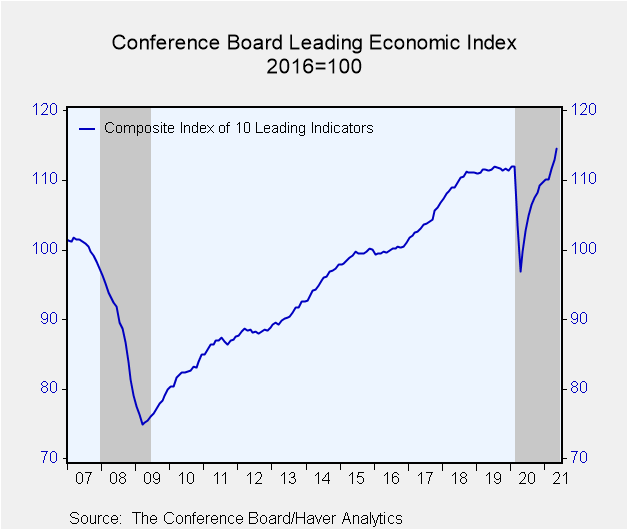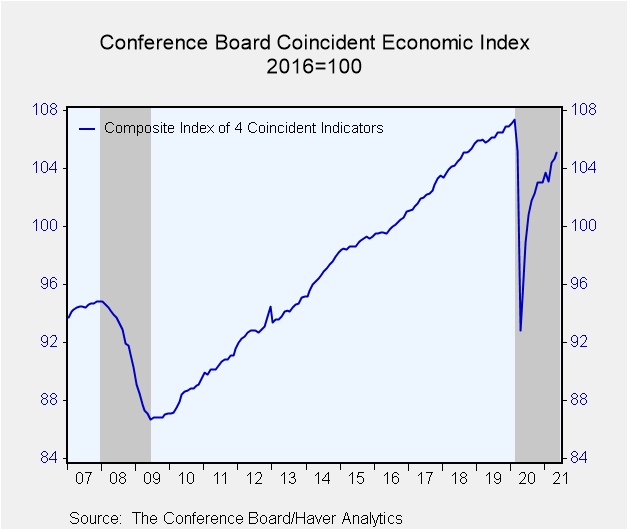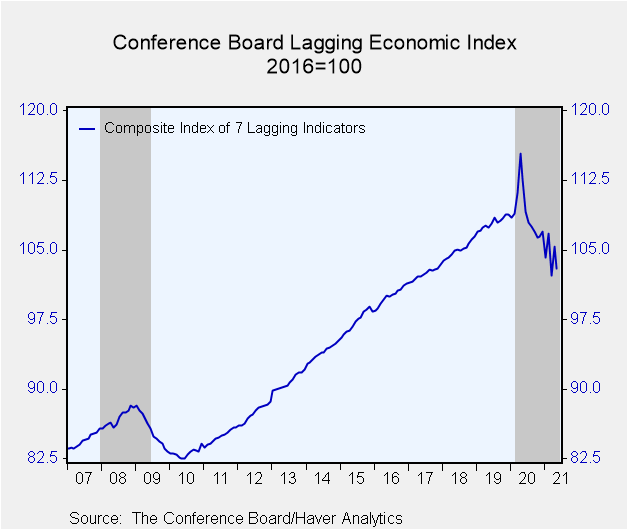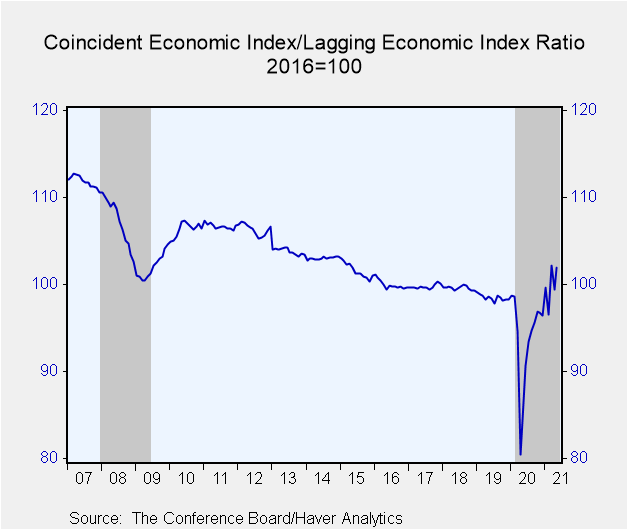 Global| Jun 17 2021
Global| Jun 17 2021U.S. Leading Indicators Post Another Strong Gain in May
by:Tom Moeller
|in:Economy in Brief
Summary
• Component improvement in leader's index remains broad-based. • Coincident indicators continue to firm. • Lagging indicators' decline suggests more economic slack. The Conference Board's Composite Index of Leading Economic Indicators [...]
• Component improvement in leader's index remains broad-based.
• Coincident indicators continue to firm.
• Lagging indicators' decline suggests more economic slack.
The Conference Board's Composite Index of Leading Economic Indicators strengthened 1.3% (14.7% y/y) during May, the same as in April, revised from 1.6%. The 1.4% March increase was revised from 1.3%. A 1.4% rise in the May index had been expected in the Action Economics Forecast Survey. The Leading Index is comprised of 10 components which tend to precede changes in overall economic activity.
Component increases in the leading indicators index included an improved ISM new orders index, fewer initial unemployment insurance claims, higher stock prices, more consumer goods orders, a steeper interest rate yield curve, improved consumer expectations and the leading credit index. Building permits and capital goods orders fell slightly while the average workweek was unchanged.
The Index of Coincident Economic Indicators increased 0.4% (10.4% y/y) following an unrevised 0.3% April rise. The index rose 1.3% in March, revised from 0.9%. Each of the four component series contributed positively to the May gain, as they did in April, including industrial production, nonfarm payrolls, personal income and manufacturing & trade sales.
The Index of Lagging Indicators fell 2.2% (-8.5% y/y) during May after rising 3.0% in April, revised from 1.8%. That followed a 4.2% March drop, revised from -3.7%. A lower consumer installment credit/income ratio accounted for all of the decline. A stronger services CPI was offset by minimal declines in other series.
The Conference Board figures are available in Haver's BCI database; the components are available there, and most are also in USECON. The expectations are in the AS1REPNA database. Visit the Conference Board's site for coverage of leading indicator series from around the world.
| Business Cycle Indicators (%) | May | Apr | Mar | May Y/Y | 2020 | 2019 | 2018 |
|---|---|---|---|---|---|---|---|
| Leading | 1.3 | 1.3 | 1.4 | 14.7 | -4.9 | 1.6 | 5.6 |
| Coincident | 0.4 | 0.3 | 1.3 | 10.4 | -4.3 | 1.6 | 2.4 |
| Lagging | -2.2 | 3.0 | -4.2 | -8.5 | 1.0 | 2.8 | 2.5 |
Tom Moeller
AuthorMore in Author Profile »Prior to joining Haver Analytics in 2000, Mr. Moeller worked as the Economist at Chancellor Capital Management from 1985 to 1999. There, he developed comprehensive economic forecasts and interpreted economic data for equity and fixed income portfolio managers. Also at Chancellor, Mr. Moeller worked as an equity analyst and was responsible for researching and rating companies in the economically sensitive automobile and housing industries for investment in Chancellor’s equity portfolio. Prior to joining Chancellor, Mr. Moeller was an Economist at Citibank from 1979 to 1984. He also analyzed pricing behavior in the metals industry for the Council on Wage and Price Stability in Washington, D.C. In 1999, Mr. Moeller received the award for most accurate forecast from the Forecasters' Club of New York. From 1990 to 1992 he was President of the New York Association for Business Economists. Mr. Moeller earned an M.B.A. in Finance from Fordham University, where he graduated in 1987. He holds a Bachelor of Arts in Economics from George Washington University.










